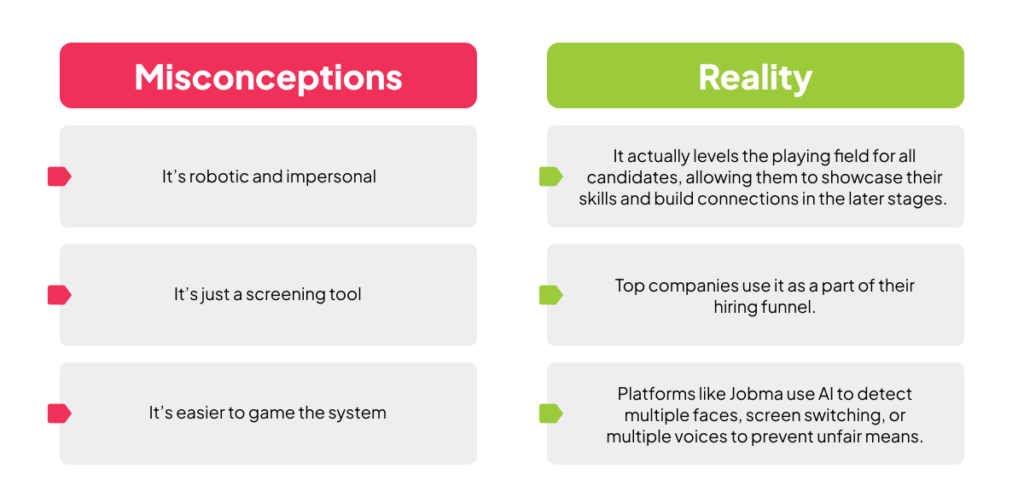Mastering One-Way, On-Demand, and Self-Paced Interviews: A Guide for Hiring Teams and Candidates
Hybrid work and remote hiring have become the norm, and the traditional way of hiring has hit a breaking point. Lengthy phone calls, scheduling conflicts, and long hiring processes are no longer suitable for today’s fast-paced hiring landscape.
From a candidate’s perspective, it may seem a little strange at first to sit in front of the laptop by themselves and record answers to pre-set questions. But today, nearly all organizations use virtual technology to recruit candidates. When there’s distance and a time zone involved, one-way interviews can make the process easier for everyone involved.
What is a One-Way / On-Demand / Self-Paced Interview?
A one-way video interview goes by many names: on-demand, asynchronous, and pre-recorded video interviews, but they all have the same concept. It is a type of job interview process where candidates record responses to pre-set questions, usually through video, without directly interacting with the interviewer. Instead of a live back-and-forth interaction with a recruiter, candidates respond to pre-set questions, all on their own time. This allows employers to review responses at their convenience and efficiently screen candidates.

As for applicants, they get a set amount of time to read each question, think through their answers, and then record a response. Depending on the employer’s preference, re-take options may or may not be available. It’s structured, efficient, and is quickly becoming the go-to format for early-stage screening.
Why Do Companies Use One-Way Video Interviewing?
Hiring is time-consuming and complex – recruiters spend 30-40% of their time scheduling and rescheduling interviews, time that could be better spent evaluating talent. A single phone screen averages 15 to 30 minutes, which quickly adds up to days of effort when dealing with hundreds of applicants. On top of that, unstructured interviews often leave room for unconscious bias to creep in, and pre-recorded interview eliminates that. With one-way video interviews, recruiters can review responses on their own time and fast-track qualified candidates, especially critical for high-volume roles.
What Does it Feel Like for Candidates?
For candidates, a one-way video interview can feel awkward at first. But if done right, it is an incredible tool to showcase your skills. You can record answers using a laptop, phone, or tablet. You’ll typically get some think time after each question, and if the employer allows retakes, you can practise and present your best self. For many job seekers, especially those with anxiety around live interviews, this format can actually feel less intimidating and more empowering.
What Technology Will You Need for a One-Way Interview?
If you’ve been invited to a one-way video interview, here’s what to prepare:
If you’re on a computer, make sure that you have a fast and stable internet connection and confirm that your webcam and microphone are working. Get into a quiet space with good lighting to minimize distractions. No downloads are necessary – a platform like Jobma allows you to open the link directly in your web browser.
If you’re on your phone or tablet, you can usually access the interview via your browser, though most platforms also offer a dedicated app. Download the app, if needed, enter your interview code, and follow the on-screen instructions.

What to Expect During a One-Way Interview?
A one-way interview is a structured way for employers to assess your skills, communication, and how well you might fit into their team. These interviews are not one-on-one, and there is no interviewer present on the other end. There’ll be on-screen prompts to guide you through the process.
Depending on the role you’re applying for, the format can vary quite a bit. It may be a text-based question where the prompt appears on the screen, you’ll be given a few seconds or minutes to prepare your thoughts and deliver your answer within a set timeline. In some cases, there will be retake options, while in other cases, there will be no do-overs.

While every company customizes its interview flow slightly, most platforms follow a similar structure, one that’s designed to be completed within 15–30 minutes, at your convenience.
One-Way, Asynchronous Video Interview Guide
A one-way video interview may feel less formal than a traditional face-to-face interview, but it needs the same level of preparation, if not more. Without a live person to interact or engage with, it’s all up to you to make a memorable impression through the camera lens. Here are some tips to help you get ready when the camera starts rolling:
Understand the Position You’re Applying For: Take a dive into the job description and research the company. Learn how the position fits into the larger goals of the company. When you understand the business value of the job, it becomes easier to explain the value you bring to it. Instead of simply listing responsibilities, talk about impact and how you improved and adapted in your past roles.
Dress Well: You might be recording from your bedroom, but the expectation remains professional. Dress appropriately, a polished appearance not only shows respect for the process but also puts you in a more professional mindset as you record.
Know Your Resume: Your resume might come up during the interview, so be prepared to discuss your career timeline, past job responsibilities, and how they tie into the position you’re applying for. So, just to be on the safer side, review your resume before recording, and have clear answers.

Use Frameworks Like STAR or SHER: To avoid rambling, structure your answers using frameworks like STAR or SHER. The STAR (Situation, Task, Action, Result) method is great for skill-based questions, like “Tell me about a time you led a team to meet with tight deadline?” using this framework, you can answer by briefly discussing situation, outline your task, explain the action you took, and end with the result.

The SHER (Situation, Hindrance, Emotion, Result) framework is helpful when you want to highlight interpersonal growth, emotional intelligence, or handling pressure. For instance, when you’re asked, “Describe a time when you received criticism?” To answer, first set the context, explain what made it challenging, talk about how the comment made you feel and react, add how you addressed the situation, and end by reflecting on your experience.
Practice Speaking to Your Webcam: You’ll get time to prepare during the interview, but it’s better to prepare beforehand to get accustomed. Talking into a lens instead of a person takes some getting used to. You can record yourself answering a few questions and watch the playback. Take note of your tone, eye contact, posture, and pacing. After a few tries, it’ll start to feel more natural.
Is AI Reviewing My One-Way Interview Answers?
While AI plays a major role in the video interviewing platform, the process is not fully automated or impersonal. AI assists with structuring the interview, flagging inconsistencies, analyzing tones and answers, essentially helping recruiters sift through large volumes of responses more efficiently. These data-driven insights may highlight patterns, but it doesn’t make the final decision. The final say rests with the hiring manager or the employer. After your video interview, your responses are reviewed by real people who evaluate your fit based on the job requirements, cultural alignment, and overall potential. The AI simply supports that process by bringing helpful information to the surface.
So, Is It Fair?
If you’re wondering how fair the process is, the use of ethical AI is to create a fairer and more consistent experience for all candidates. It flags distractions like background noise or multiple people in the frame. It detects screen-switching or voice prompts, preventing unfair practices without penalizing honest candidates.
This means your responses are reviewed on a level playing field, everyone gets the same prep time, the same questions, and a structured format. For hiring teams, it cuts unconscious bias at the screening stage, while for candidates, it creates a more transparent, equitable experience.
Common Misconceptions & What’s Actually True

Common One-Way Interview Questions and Answers
If you’re preparing for a one-way interview for the first time, below is a list of the top common questions you can anticipate.
Why are you interested in this role?
Instead of talking about what you think they want to hear, tell them what truly excites you about the role. Connect your past experiences with the company’s goals. This is your chance to show that you’ve done your research and that you’re invested.
Tell me a bit about yourself and your background in brief.
Frame your background like a journey that naturally led you to this role. Start with a specific moment, experience, or realization that pulled you into this career path. Follow it up with how your education helped shape your skills, then tie it all together with relevant work experiences or standout projects. The goal is to make them see the progression and feel like hiring you is the next logical step in your story.
What’s your biggest strength (and weakness)?
Choose the strengths that align with the role requirement, whether it’s communication, problem-solving, or leadership, and back them up with examples.
Tell us about a time you made a mistake and how you handled it.
Pick a genuine area you struggled with and show how you worked to improve it. Set the scene, explain the challenges, walk them through what you did, and end with how you solved it. The key is self-awareness and growth. Make it clear you’re proactive and open to learning.
Final Thoughts!
The days of “Can you come in for an interview at 11 AM?” are fading. Hiring today requires speed, scale, and structure, and one-way interviews are leading the way. For candidates, it’s a chance to tell your story your way. For employers, it’s a smarter way to spot great talent sooner. With ethical AI at play, evaluation has reached new heights, offering insights that support fair and unbiased hiring.

FAQs
What to remember while in the one-way interview?
Treat it like a live interview, dress professionally, sit in a quiet, well-lit space, and follow the instructions carefully. Keep answers clear, concise, and aligned with the role. Be mindful of the timer (if there is one), and always re-read the question before responding to stay on track.
How to talk to a camera in a video interview?
Look directly at the webcam, not your screen, to mimic eye contact. Imagine you’re speaking to a real person – this helps you sound natural and confident. Smile occasionally, maintain good posture, and practice your responses beforehand to reduce filler words or long pauses.



